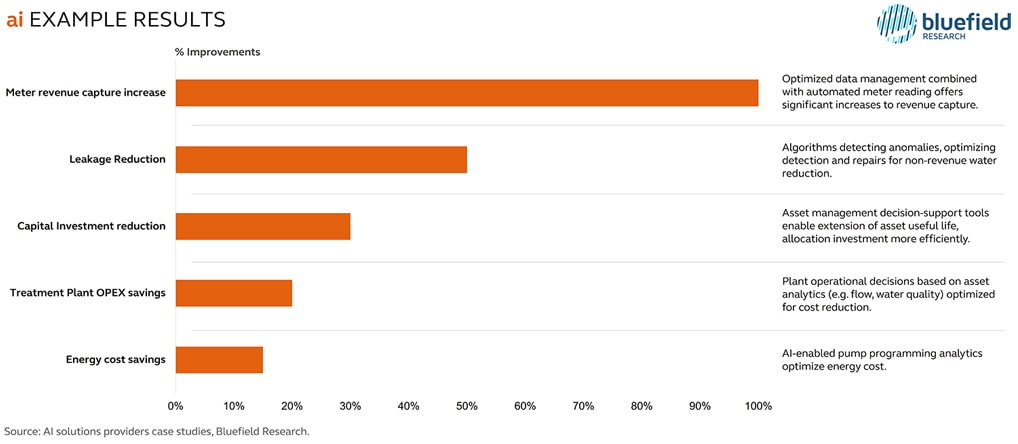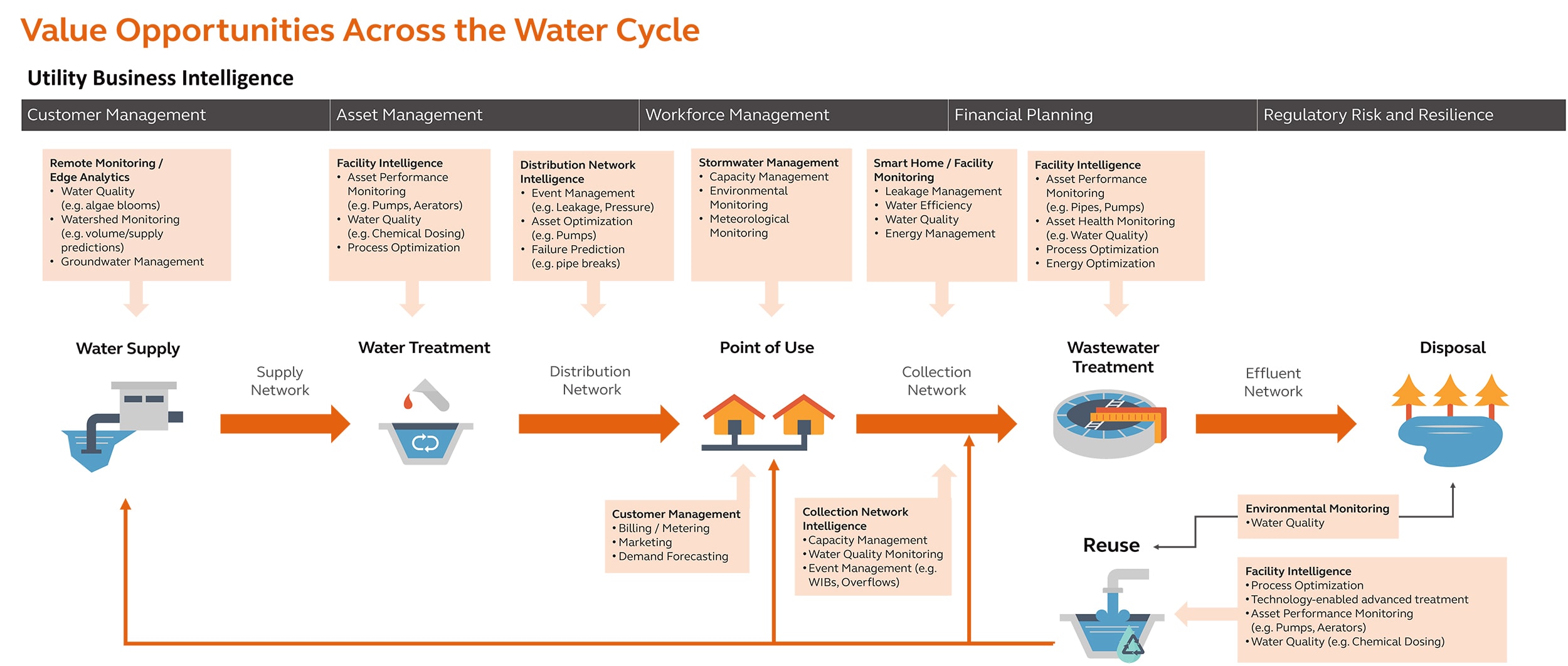In the first article of our AI for Water series, we explored how artificial intelligence (AI) can revolutionize the water sector by optimizing water management and addressing challenges like urbanization, climate change, and workforce shortages. We also discussed how AI is essential for future innovation and not just a buzzword to characterize temporary change in the water industry. In the second part of our AI for Water series, we're diving deeper into what it takes to build your business case and jumpstart your AI initiative.
According to Bluefield Research, AI is poised to see rapid growth through 2030 in the water sector, making it crucial for organizations to question what it takes to implement AI in their operations. The primary motivators for AI adoption, such as compliance deadlines, workforce shortages and operational efficiencies—through automation of complex systems and early leak detection—highlight the inevitability of AI in the industry. Understanding the barriers to AI adoption is essential for organizations questioning how and when to implement AI.
Recent examples, such as energy optimization, pipe replacement optimization, or generative design, confirm the value of AI but highlight areas that need attention. In agreeance with Bluefield, we believe the top three barriers from an industry view include:

Personnel/skills
Not having staff or consultants who know how to use or manage AI

Risk
Uncertainty about return on investment or long payback time for investment in AI making organizations slow to adopt new technology

Funding
Not having the money to commit to AI projects
Overcoming these barriers to implementing AI requires financial investment, time, and training upfront. Understanding the key questions that are top-of-mind throughout an organization is essential to making the right decision and successfully implementing AI.
Thinking about implementing AI? Consider this.
C-Suite: Does the implementation of AI support our objectives, and will it deliver sustainable value?
Case studies compiled by Bluefield Research from utilities around the world highlight some of the common operational improvements reported because of artificial intelligence. When applied correctly, AI aids in cost management by helping avoid rate increases, grow the general fund at utilities, and increase profitability through optimized resource utilization and reduced expenditures. Additionally, AI provides connected and reliable data, enabling early responses to operational failures such as leaks, which minimizes downtime and service disruptions.
Click to enlarge
-
Read More
The impact on capital and operational expenditure is substantial. According to Autodesk, AI can save 20-30% on operational expenditures (OPEX) by reducing energy costs. These savings contribute to a more sustainable and cost-effective operation. Furthermore, AI integration allows for more informed and strategic capital expenditure (CAPEX) decisions. By predicting future infrastructure needs and maintenance, AI helps allocate capital more efficiently, potentially reducing the need for large-scale immediate investments.
As an example, Arcadis is supporting the City of New London in Connecticut to replace its lead water service lines to ensure lead-free drinking water for its 60,000 customers. The City’s decision to implement the Lead Service Line Replacement Program is bold as it is one of the first utilities to execute a proactive lead service line program. It’s indicative of upcoming regulatory compliance rules that will likely reach states in the U.S. in the coming years. Using AI, the City will be able to efficiently inspect and replace its pipeline, optimizing costs given the volume of pipe that needs to be assessed.
AI has the capacity to enhance operational capacity, achieve significant OPEX savings, and improve CAPEX efficiency. This alignment can avoid rate increases, grow the general fund at utilities, and increase profitability, thereby delivering sustainable value to the water and wastewater industry.
Procurement: Can AI solutions really bring value to our organization?
Several factors will influence the scale and scope of the initial investment required for AI implementation, including infrastructure costs, data management, training and change management and ongoing maintenance and support. However, undoubtedly, there are significant gains from implementing AI regardless of the upfront costs.
The following graphic outlines the value opportunities across the entire water cycle because of AI implementation:
Click to enlarge
AI has the capacity to drive efficiencies throughout the entire water cycle. By pinpointing where your operations are being impacted by technical and physical issues, AI will help identify where investments need to be made to bring the most value to your organization.
IT/Technology: What data infrastructure do we need to support AI implementation?
To support AI implementation in the water sector, robust and scalable data infrastructure is crucial. This infrastructure should encompass high-capacity data storage solutions, ensuring real-time data processing and integration capabilities. Cloud-based platforms can provide the necessary flexibility and scalability, allowing for the storage of vast amounts of data generated by IoT sensors and monitoring systems. Additionally, robust data pipelines must be established to ensure seamless data flow from collection points to AI algorithms, facilitating timely analysis and decision-making. Advanced analytics and machine learning models require powerful computational resources, which can be provided through high-performance computing clusters or cloud-based solutions.

-
Read More
From a technology perspective, implementing AI involves integrating these computational resources with existing SCADA (Supervisory Control and Data Acquisition) systems and other IT infrastructures to create a cohesive, intelligent water management system.
As an example of data integration and quality, Tarrant Regional Water District (TRWD) provides water to nearly 2.3 million people in north Texas, a rapidly growing area with fluctuating energy prices due to its deregulated electricity market. The district’s leadership recognized a need to improve operational efficiency by increasing consumption visibility to address fluctuating energy costs. Arcadis worked with TRWD to implement a Power and Market Monitoring Tool which helped visualize costs for pumping water and water consumption patterns. As a result, TRWD can anticipate market energy price, optimize operations accordingly, and save significant pumping costs. This showcases the value data integration and quality can have on organizational finances.
Technical experts and specialists: How will this impact the way I work?
Change in the workplace can, at times, seem daunting, but the impacts of AI on the workforce are quite clear. In simple terms, AI can automate repetitive tasks and process data at an expedited speed to help operators manage challenges quickly. Additionally, AI-driven simulations can optimize water distribution networks, improve resource allocation and reduce waste, and facilitate real-time water quality monitoring and rapid response to contamination events, ensuring public safety. By automating routine tasks and providing deeper insights, AI will allow water experts to focus on strategic planning and innovation, ultimately enhancing the sustainability and resilience of water management systems.
At a glance, Bluefield Research has compiled a summary of the anticipated changes AI will bring to roles:

Utility new roles
-
Data Scientists
Responsible for developing and implementing machine learning algorithms and models for leak detection and prediction. Analyze large datasets to identify patterns, anomalies, and trends related to potential leaks.
-
Software Engineers
Develop and maintain the software infrastructure for deploying AI models. Integrate AI solutions into existing utility systems and ensure seamless communication with other software components.
-
Utility Engineers
Professionals with a deep understanding of the specific utility system (e.g., water, wastewater, stormwater). Provide domain-specific knowledge to guide the development of AI models and interpret their results.
-
Data Engineers
Responsible for data collection, cleaning, and preprocessing to ensure high-quality input for AI models. Build and maintain data pipelines to support ongoing monitoring and analysis.
-
IoT Specialists
Design and manage sensor networks for real-time monitoring.
-
Cybersecurity Experts
Ensure the security of data and AI models to prevent unauthorized access and potential manipulation. Implement robust cybersecurity measures to protect against potential threats.
-
Project Managers
Oversee the entire AI implementation project, ensuring that timelines are met and resources are allocated effectively. Coordinate communication among team members and stakeholders.
-
Regulatory Compliance Specialists
Ensure that the implementation of AI complies with relevant regulations and standards in the utility industry.
-
GIS Specialists
Integrate geographical data into the AI models to enhance spatial analysis for leak detection and prediction.
-
User Interface (UI) and User Experience (UX) Designers
Develop user-friendly interfaces for utility personnel to interact with the AI system. Ensure that the AI insights are presented in a comprehensible manner.
-
Field Technicians
Personnel who can respond to alerts generated by the AI system, investigate potential leaks, and carry out necessary repairs.

At Arcadis, we’ve embraced AI tools to help streamline and enhance the way we work. Our innovative Asset Generator, powered by Autodesk, exemplifies this approach by streamlining design visualization, enabling our technical experts and designers to collaborate seamlessly on a unified platform. While AI often raises concerns about job displacement, our Asset Generator highlights how we've integrated AI to enhance productivity and efficiency without compromising the need for technical expertise. This tool empowers our team to focus on higher-value tasks, demonstrating that AI can be a powerful ally in advancing our work.
Human resources: How can we responsibly and ethically implement AI?
One of the top concerns related to implementing AI is not having staff or consultants who know how to use or manage AI. This concern becomes a fundamental principle for how AI should be implemented. As AI is integrated into a system, it is essential to create clear lines of communication and provide upskilling and digital training to staff, ensuring they are well-equipped to harness this technology effectively.

According to Autodesk, 39% of professionals believe that AI can help automate mundane, repeatable tasks, freeing time for staff to focus on more complex and critical activities and resulting in more meaningful work. Furthermore, AI can play a crucial role in bridging the skills gap and addressing workforce shortages, particularly in the face of an aging water workforce. By leveraging AI, organizations can support their employees in adapting to evolving industry demands and ensure the continuity and excellence of their services.
Making AI implementation a reality
Once an organization has decided to implement AI, the next steps are crucial to ensure a successful integration. Consider these next steps:



The promise of AI is great, but it’s important to ensure your organization experiences the benefits of its implementation by properly planning.
In our next article, we’ll dive deeper to understand how AI can enable performance improvements through automation and discuss water security and safeguarding utilities against hacking.

AI for Water: A game-changer or a pipe dream?
Paired with human intelligence, AI has the power to tackle many of the water sector’s most pressing problems. But, what are the key building blocks to be considered when it comes to AI and water?









